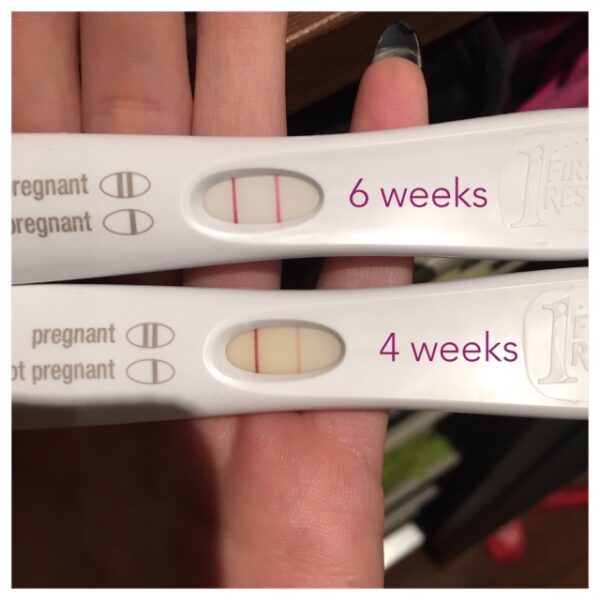Are you meticulously tracking those faint lines on your pregnancy tests, agonizing over every shade and shadow? Understanding the significance of a "dye stealer" can bring clarity to the often-turbulent waters of early pregnancy, offering a beacon of hope amidst the anxieties.
The quest for that definitive, bold positive on a pregnancy test is a journey many women undertake. The appearance of a "dye stealer" where the test line becomes so intensely colored that it seemingly "steals" the dye from the control line, making the control line appear lighter is often seen as a milestone. One individual reported a dye stealer at 14 days post-ovulation (dpo) using a First Response test, yet still didn't achieve the same result on easy@home tests at 20 dpo. While the tests were undeniably positive, the lines were of comparable intensity. This situation raises a common question: does the timing of a dye stealer correlate with the health or outcome of a pregnancy?
The world of early pregnancy is fraught with uncertainties, and the pursuit of reassurance through at-home testing can be a double-edged sword. For some, the absence of a dye stealer, even with rising HCG levels, can spark concern. One account details a previous pregnancy that ended in a blighted ovum, with the lack of a dye stealer at 20 dpo being an early indicator. Similarly, in another experience, a dye stealer at 17 dpo didn't guarantee a viable pregnancy, ultimately resulting in an ectopic pregnancy despite normal progesterone and initially doubling HCG levels. These experiences underscore the complexity of early pregnancy and the limitations of interpreting at-home tests.
Many women meticulously monitor their pregnancy tests, seeking reassurance through the darkening of the test line. However, as one person learned, the progression of lines doesn't always tell the whole story. This individual experienced a delayed dye stealer, finding their first one at 18 dpo, and despite initial anxieties, they are now at 17 weeks and 5 days. This highlights the fact that every pregnancy is unique, and the absence of a dye stealer in the early days doesn't always predict a negative outcome. One user shared their experience on r/tfablineporn, they shared that they got their first dye stealer on 15dpo (4w2d) with frr, frer i got one on 17dpo (4w4d)but i didn\u2019t get a dye stealer with easy@home until 19dpo after the 5w mark and premom took until 21dpo!
| Category | Details |
|---|---|
| Pregnancy Test Type | Home pregnancy tests, including First Response, easy@home, Premom, and Clearblue Digital |
| Hormone Measured | Human Chorionic Gonadotropin (hCG) |
| Dye Stealer Definition | When the test line is darker than the control line, appearing to "steal" dye. |
| HCG Level | Varies, but generally high, often several weeks into pregnancy. A normal range for a 4-week pregnancy is 5-426 mIU/ml. |
| Time of Occurence | Can occur at various times, but typically after a missed period, often well into the first trimester. However, can occur earlier for some women. |
| Significance | Indicates high and rapidly rising hCG levels, a positive sign for a healthy pregnancy, but not a definitive predictor. |
| Possible Outcomes | Healthy pregnancy, miscarriage, ectopic pregnancy (not always predictive). |
| Factors Influencing Timing | Test sensitivity, individual hormone levels, and specific test brands. |
| When to Seek Professional Advice | When there is bleeding, severe pain, or any other unusual symptoms. Always seek advice from a healthcare professional regarding any concerns. |
For more in-depth information on home pregnancy test results, consider visiting: Mayo Clinic.
The narratives offered here are varied. One individual, despite an initial HCG of 601 at 15 dpo, didn't get a dye stealer on easy@home tests at 20 dpo. Conversely, others report dye stealers at different times, such as 14 dpo on First Response, or even later. The brand of test also plays a role, as some cheap tests take longer to show a dye stealer. A dye stealer result can occur earlier in pregnancy, including at 5 weeks, particularly in women with high hCG levels. However, at 5 weeks pregnant, it may indicate that your hcg levels are increasing, which is generally a positive sign of a healthy pregnancy.
In the early stages, the emotional weight of this is intense. The desire to see the test line darken quickly, the reassurance that comes with a strong positive, are potent motivators for many. There is an immense amount of anxiety around this time of pregnancy. However, as one individual's experience indicates, the progression of line darkness does not always reflect the health of the pregnancy.
While at-home tests provide a degree of early insight, they are not without limitations. As one user emphasized, the tests simply confirm pregnancy. More detailed information comes from blood tests (beta HCG levels) and ultrasounds. Another person who got a dye stealer at 18 dpo, experienced a "stunning" result at that stage, which illustrates the potential for an early and robust indication of a rising HCG level. However, it's crucial to realize that not everyone experiences a dye stealer. Many individuals share their experiences of not getting a dye stealer. One shared that they stopped testing around 6 weeks after not getting a dye stealer and received a 6+ reading on the clear blue digital test.
One's experiences remind us that the absence of a dye stealer does not automatically equate to a negative outcome. While a dye stealer is generally a positive sign, the absence of one is not necessarily indicative of a problem. Getting a dye stealer pregnancy test result means that your hcg levels are very high.
The ability of the test line to "steal" dye from the control line is tied directly to the level of HCG in the woman's system. This is why this phenomenon is likely to happen once HCG levels are high, which typically happens several weeks into pregnancy, and often after a missed period and well into the first trimester. However, as highlighted, there are many variables at play. Different test sensitivities, individual hormonal responses, and even the brand of the test can impact the timing and appearance of a dye stealer. The cheap tests can sometimes take longer to show a dye stealer.
Several factors can influence the appearance of the test lines, including the time of day the test is taken (first morning urine typically has the highest HCG concentration) and the sensitivity of the test itself. Some tests are designed to detect lower levels of HCG than others, which can affect how quickly a dye stealer appears. If your control line disappears completely, you should retake your test using a different test strip.
The concept of a chemical pregnancy is introduced as a miscarriage before 5 weeks. Miscarrying later than that is not considered a chemical pregnancy, which is another factor.
The dye stealer also carries the potential for creating extra anxiety. The tests are capable of indicating a pregnancy, but they cannot provide definitive insights into the health of the pregnancy, or provide warnings for ectopic pregnancies.


Detail Author:
- Name : Mr. Lemuel Tillman IV
- Email : tamara93@hotmail.com
- Birthdate : 1997-11-29
- Address : 3833 O'Kon Rest Cassandrefurt, AR 73904-3065
- Phone : (908) 263-0656
- Company : Volkman, Steuber and Leffler
- Job : Coaches and Scout
- Bio : Adipisci perspiciatis aut a id enim voluptatum ratione eius. Et cum laudantium aliquid adipisci ut corrupti mollitia. Et dolorem dolores repudiandae similique minus odio eaque.